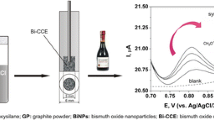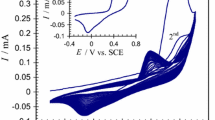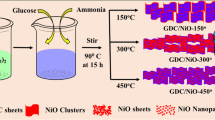Abstract
A carbon composite amperometric hydrogen peroxide sensor has been developed using a sol-gel technique. Toluidine blue (TB), which acts as the redox mediator, was covalently immobilized via glutaraldehyde crosslinking with an organically modified silane, namely 3-aminopropyltrimethoxysilane (APTMOS). Methyltrimethoxysilane (MTMOS) was used as the additional monomer; this controls the hydrophobicity of the electrode surface, thus limiting the wettability. The immobilization of TB within the sol-gel matrix was confirmed with FTIR studies. The sol-gel mixture containing TB immobilized in APTMOS and MTMOS was mixed with graphite powder in order to prepare the carbon composite electrode. The electrode was characterized using voltammetric techniques and its electrocatalytic activity for the reduction of hydrogen peroxide was also studied. The carbon composite electrode has the advantage of sensing H2O2 at a lower potential and with a higher sensitivity, and interferences due to ascorbic acid, uric acid and acetaminophen were greatly minimized. The linear range for the determination of H2O2 extends from 5.37 × 10−6 to 6.15 × 10−3 M, with a correlation coefficient of 0.9981. The detection limit was found to be 2.15 × 10−6 M. The covalent immobilization of TB effectively prevents the leakage of the water-soluble mediator during measurements. The modified electrode, aside from electrocatalyzing the reduction of H2O2, exhibits distinct advantages in terms of surface renewal in the event of surface fouling, as well as simple preparation, good chemical and mechanical stability, and good reproducibility.

Amperometric hydrogen peroxide sensor based on sol-gel-derived ceramic carbon composite electrode with toluidine blue covalently immobilized using 3-aminopropyltrimethoxysilane







Similar content being viewed by others
References
Lobnik A, Cajlakovic M (2001) Sens Actuators B 74:194–199
Westbroek P, Van Hayte B, Temmerman E (1996) Fresenius J Chem 354:405–409
Liu X, Xu Y, Ma X, Li G (2005) Sens Actuators B 106:284–288
Hurdis EC, Romeyn H Jr (1954) Anal Chem 26:320–325
Genfa Z, Dasgupta PK, Edgemond WS, Marx JN (1991) Anal Chim Acta 243:207–216
Chai XS, Hou QX, Luo Q, Zhu JY (2004) Anal Chim Acta 507:281–284
Rocha FRP, Torralba ER, Reis BF, Rubio AM, de la Guardia M (2005) Talanta 67:673–677
Lin Y, Cui X, Li L (2005) Electrochem Commun 7:166–172
Tseng KS, Chen LC, Ho KC (2005) Sens Actuators B 108:738–745
Gorton L, Lindgren A, Larsson T, Munteanu FD, Ruzgas T, Gazaryan I (1999) Anal Chim Acta 400:91–108
Ravi Shankaran D, Sriman Narayanan S (2002) Sens Actuators B 86:180–184
Nalini B, Sriman Narayanan S (1998) Electroanalysis 10:779–783
Deepa PN, Sriman Narayanan S (2001) Bull Electrochem 17:259–264
Walcarius A (1998) Electroanalysis 10:1217–1235
Wang J (1999) Anal Chim Acta 399:21–27
Tess ME, Cox JA (1999) J Pharm Biomed Anal 19:55–68
Lev O, Wu Z, Bharathi S, Glezer V, Modestov A, Gun J, Rabinovich L, Sampath S (1997) Chem Mater 9:2354–2375
Alber KS, Cox JA (1997) Mikrochim Acta 127:131–147
Collinson MM (1998) Mikrochim Acta 129:149–165
Tsionsky M, Gun G, Glezer V, Lev O (1994) Anal Chem 66:1747–1753
Pankratov I, Lev O (1995) J Electroanal Chem 393:35–41
Lev O, Tsionsky M, Rabinovich L, Glezer V, Sampath S, Pankratov I, Gun J (1995) Anal Chem 67:22A–30A
Wang J, Parsad VA, Park DS (1997) Electroanalysis 9:52–55
Wang J, Pamidi VA, Park DS (1996) Anal Chem 68:2705–2708
Gun J, Lev O (1996) Anal Chim Acta 336:95–106
Yuan Y, Wang P, Zhu G (2002) Anal Bioanal Chem 372:712–717
Munteanu FD, Okamoto Y, Gorton L (2003) Anal Chim Acta 476:43–54
Chen Y, Yuan J, Tian C, Wang X (2004) Anal Sci 20:507–511
Persson B (1990) J Electroanal Chem 287:61–80
Ramesh R, Sampath S (2000) Anal Chem 72:3369–3373
Santos AS, Pereira AC, Kubota LT (2002) J Braz Chem Soc 13:495–501
Sampath S, Lev O (1996) Anal Chem 68:2015–2021
Katz E, Schlereth DD, Schmidt HL, Olsthoorn AJ (1994) J Electroanal Chem 368:165–171
Liang R, Qiu J, Cai P (2005) Anal Chim Acta 534:223–229
Taranekar P, Fan X, Advincula R (2002) Langmuir 18:7943–7952
Laviron E (1979) J Electroanal Chem 101:19–28
Acknowledgement
The authors thank the University Grants Commission (UGC) for its financial assistance through University With Potential For Excellence (UWPFE) Project and Department of Science and Technology, New Delhi.
Author information
Authors and Affiliations
Corresponding author
Electronic supplementary material
Below is the link to the electronic supplementary material.
Fig. S1
FTIR of (a) free toluidine blue and (b) toluidine blue immobilized in a sol-gel matrix (DOC 184 kb)
Rights and permissions
About this article
Cite this article
Thenmozhi, K., Sriman Narayanan, S. Amperometric hydrogen peroxide sensor based on a sol-gel-derived ceramic carbon composite electrode with toluidine blue covalently immobilized using 3-aminopropyltrimethoxysilane. Anal Bioanal Chem 387, 1075–1082 (2007). https://doi.org/10.1007/s00216-006-0992-2
Received:
Revised:
Accepted:
Published:
Issue Date:
DOI: https://doi.org/10.1007/s00216-006-0992-2




